| |
|
|
| |
At last.
Sat 24th September, 2011
|
|
|
|
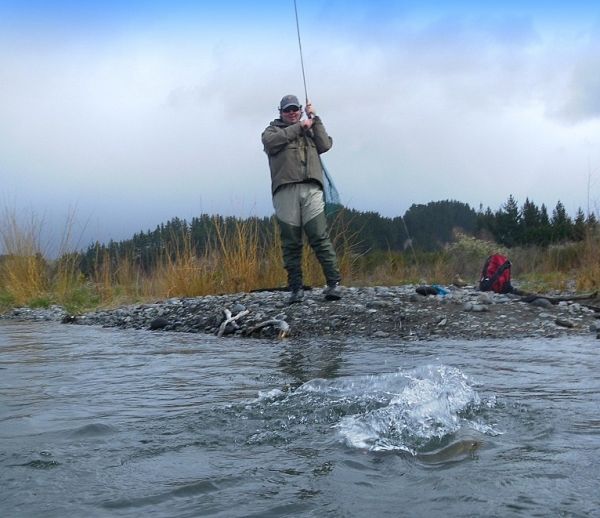
As everyone predicted last weekends recreational release and the little bit of rain a day or two later has seen the best runs so far this year. As the levels fell back and the color dropped out Sunday was especially good and you just couldn't miss, in fact I had my best day on the river for quite some time. Admittedly not every fish was a classic fresh run rainbow, there were some recovering fish and a couple of smaller silver fatties but most of them were in great nick and I had an exciting days sport as more runs came through.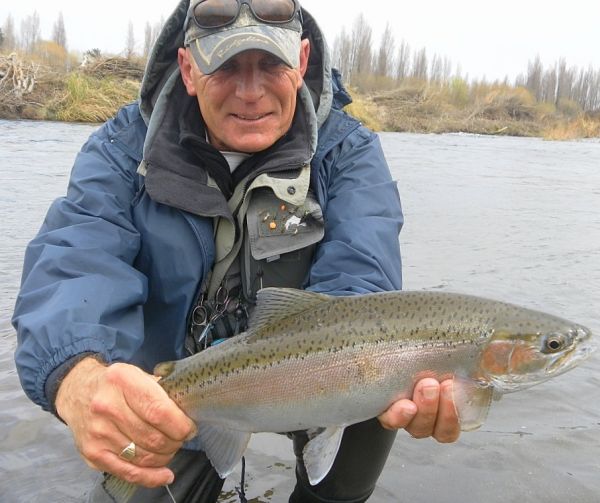
At the start of the week I fished with Paul Anderson {above} for two days. Paul is from Tasmania and an excellent fly-fisherman, over his four and a half day trip on the Tongariro he told me before he left that his final tally was approximately seventy. One morning before we met up he took over a dozen out of the Bridge Pool which generated a lot of interest with the locals who came up to ask him the name of the "killer fly", incidentally it was just a small salmon pink globug, which accounted for most of his fish this trip. Again I'm not going to pretend that all of them were the fantastic looking fish that made the Tongariro world famous but Paul mentioned that he could see an improvement compared with his last visit to NZ. Although he has fished both North and South Island rivers Paul has a bit of a soft spot for the Tongariro. When he left on Tuesday he was a little down in the dumps but looking forward to the rest of his latest round the world fishing marathon. I don't think I'd be too depressed, his next destination is Iceland, then Canada, the U.S.A and just to help recover from all that stressful fly-fishing a few days in Hawaii. Paul writes for a Tasmanian magazine and has promised to send me a full report of his adventures...it should make interesting reading.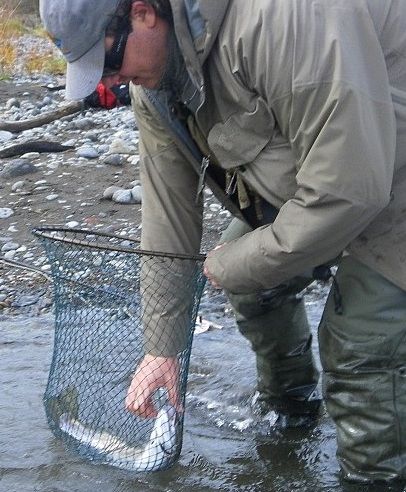 While fishing one stretch Paul had commented on the fighting qualities of New Zealand rainbows which prompted me to re-visit www.bcadventure.com While fishing one stretch Paul had commented on the fighting qualities of New Zealand rainbows which prompted me to re-visit www.bcadventure.com
In a previous post I'd used some amazing bits of info from Ron Newman's article "The Extraordinary Rainbow"...reading the rest of it you wonder how we ever manage to get one any where near the bank.
"And just how strong is that Rainbow Trout? A trout of three pounds can easily break a leader tested to six-pound strength. That's double its body weight. I defy you to break, rather than cut, monofilament tested to just your own body weight. Few members of the animal kingdom can accomplish this feat but some larger trout do this on a regular basis. Rainbow Trout are also known for their jumping ability. A Rainbow can easily leap into the air three or four times its body length. In the animal kingdom, jumping to a height of more than two body lengths is uncommon even on dry land. The household Cat and a few other members of the animal kingdom can make similar leaps but that doesn't detract from this incredible ability. In human terms, the trout is jumping 18 to 24 feet into the air out of a swimming pool.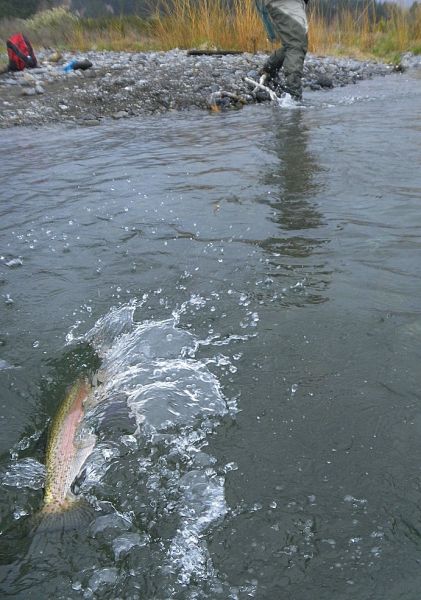 The sensory input received by a Rainbow is estimated to be 500 to 800 times more acute than the sensory input received by a human. This fish can perceive its surrounds to a degree that we can only imagine. The fish's brain is entirely devoted to bodily functions and sensory input. It doesn't possess a Cerebrum and yet is quick to learn from experience. The Cerebrum is the center for thought and reasoning in humans. The eyes of a Rainbow do not have eyelids. They are quite sensitive to bright sunlight. A trout is somewhat near sighted but can see quite well up to distances of about twenty feet. Sight is used to locate food at close distances while its other senses are used to locate food at further distances. The eyes of the Rainbow are well designed for seeing color. They see color in the red to blue wavelengths about the same as a human. However, in the yellow to green wavelengths the trout see color much better than we do. Part of the reason for this enhanced color perception is that the yellow to blue wavelengths of light travels better in water than in air. Having the eyes on the side of the head also gives the Rainbow Trout a different perspective on the world. This placement of the eyes allows the fish to see to the front, sides and most of the way behind. The only blind spots are immediately behind and directly below the fish. Upward and directly in front, the fish has depth perception or binocular vision as both eyes come into play. Toward the rear and to either side, only the eye on that side is used and the trout has monocular vision without depth perception. Viewed from below, the water surface reflects light when viewed at an angle. So the trout can only see the upper world through a small round 'window' that is directly above and has a diameter that is about twice the depth of the fish. A trout cruising 10 feet down can only 'see' a dry fly presented within about 20 feet of its location". The sensory input received by a Rainbow is estimated to be 500 to 800 times more acute than the sensory input received by a human. This fish can perceive its surrounds to a degree that we can only imagine. The fish's brain is entirely devoted to bodily functions and sensory input. It doesn't possess a Cerebrum and yet is quick to learn from experience. The Cerebrum is the center for thought and reasoning in humans. The eyes of a Rainbow do not have eyelids. They are quite sensitive to bright sunlight. A trout is somewhat near sighted but can see quite well up to distances of about twenty feet. Sight is used to locate food at close distances while its other senses are used to locate food at further distances. The eyes of the Rainbow are well designed for seeing color. They see color in the red to blue wavelengths about the same as a human. However, in the yellow to green wavelengths the trout see color much better than we do. Part of the reason for this enhanced color perception is that the yellow to blue wavelengths of light travels better in water than in air. Having the eyes on the side of the head also gives the Rainbow Trout a different perspective on the world. This placement of the eyes allows the fish to see to the front, sides and most of the way behind. The only blind spots are immediately behind and directly below the fish. Upward and directly in front, the fish has depth perception or binocular vision as both eyes come into play. Toward the rear and to either side, only the eye on that side is used and the trout has monocular vision without depth perception. Viewed from below, the water surface reflects light when viewed at an angle. So the trout can only see the upper world through a small round 'window' that is directly above and has a diameter that is about twice the depth of the fish. A trout cruising 10 feet down can only 'see' a dry fly presented within about 20 feet of its location".
Lots more fishy facts to come, so Part Two next week.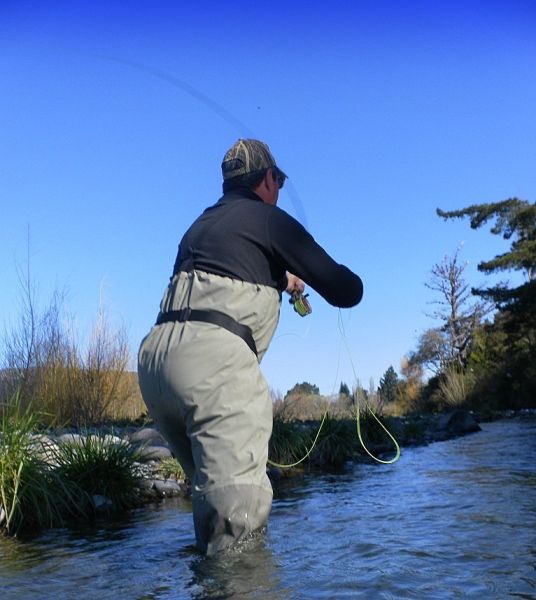
Today I was out with another Paul...Paul Welling from the UK who is visiting Aotearoa on a combined fishing-rugby trip...in that order. Paul has tried all sorts of angling styles, coarse, saltwater, salmon...you name it...but loves trout fly-fishing. From the start of our morning together he made me aware that he'd been at it long enough to know why it was called "fishing not catching" and told me that when salmon fishing you were sometimes lucky if you got one fish every three trips. We headed over to the Braids but it was 7.45am on a beautiful morning and unsurprisingly there were already several anglers and a couple of guides there. Even so Paul rolled a couple of fish in the riffles but with excitement levels high missed them. Next stop was Judges, mainly because there were no cars parked on the north side of the bridge. Unfortunately when we got up there that to was already occupied and we didn't stay long. To be honest I've been quite disappointed with this pool for a while, it doesn't chuck them out like it used too. For the last few years it was a "banker" and the head was always very kind to me, it'll be interesting to see how it fishes in future.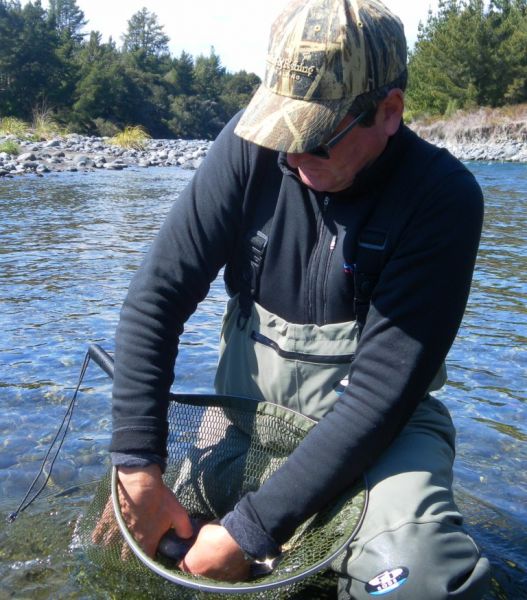 So it was back to the truck and we headed upriver to the Blue Pool, after parking up a quick look around revealed there wasn't another angler insight. We waded across to the TRB, walked downriver to Boulder and began fishing the tail...its amazing...you can watch that indicator like a hawk and nothing happens until you turn your back. I'd just finished watering the native bushes and as I looked around Paul was already playing a fish. Before I could get there it went off "on one" and threw the fly but the tell tale fish scale hanging in the bend of the hook told the story. Ten minutes later Paul was in again fortunately this time the fish had the rubber-leg bomb firmly stuck in its jaw and was safely released after a few pics. During the last couple of weeks there has been increasing mayfly hatches, usually starting around mid-morning and continuing til late afternoon. The birds are always first to pick up on this and as if from nowhere we had fantails perched in the branches on the far bank and many more hopping amongst the boulders behind us. Sure enough a few minutes later the first of the mayflies began to " come off " the water. A change to a small pheasant tail had Paul hooked up to a hen and before we left he had a couple of near misses and another in the net. Paul had been thinking of retiring to the South of England but after this first trip to New Zealand there may be a change of plan. Thanks Paul and we'll keep that new method you discovered to ourselves eh! So it was back to the truck and we headed upriver to the Blue Pool, after parking up a quick look around revealed there wasn't another angler insight. We waded across to the TRB, walked downriver to Boulder and began fishing the tail...its amazing...you can watch that indicator like a hawk and nothing happens until you turn your back. I'd just finished watering the native bushes and as I looked around Paul was already playing a fish. Before I could get there it went off "on one" and threw the fly but the tell tale fish scale hanging in the bend of the hook told the story. Ten minutes later Paul was in again fortunately this time the fish had the rubber-leg bomb firmly stuck in its jaw and was safely released after a few pics. During the last couple of weeks there has been increasing mayfly hatches, usually starting around mid-morning and continuing til late afternoon. The birds are always first to pick up on this and as if from nowhere we had fantails perched in the branches on the far bank and many more hopping amongst the boulders behind us. Sure enough a few minutes later the first of the mayflies began to " come off " the water. A change to a small pheasant tail had Paul hooked up to a hen and before we left he had a couple of near misses and another in the net. Paul had been thinking of retiring to the South of England but after this first trip to New Zealand there may be a change of plan. Thanks Paul and we'll keep that new method you discovered to ourselves eh!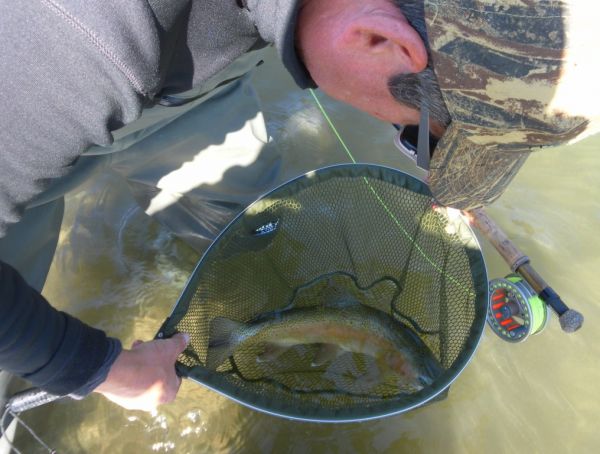 Its been a great week to be on the Tongariro and at last there are good reports from the upper river making a session up there a bit more than just a pleasant walk. This should go some way to alleviate the pressure around the town pools and lower river giving anglers a worth while change of scenery. With the weather beginning to warm up and the first fish, probably returning kelts taking the odd fly off the surface, summer fishing is just around the corner. There are some rumours of rain tomorrow but it doesn't look as if its going to amount to much. Next week the forecast is a return to frosty mornings and mainly fine days so very agreeable fishing conditions. Runs will continue until they peak but its anyone's guess when that will be. I'm out again tomorrow and really looking forward to it, you may remember Mark Tomsett from a month or so back. This time he's bringing along a mate...a cycling, pig-hunting pugilist with a degree in Bio-chemistry...can't wait. Its been a great week to be on the Tongariro and at last there are good reports from the upper river making a session up there a bit more than just a pleasant walk. This should go some way to alleviate the pressure around the town pools and lower river giving anglers a worth while change of scenery. With the weather beginning to warm up and the first fish, probably returning kelts taking the odd fly off the surface, summer fishing is just around the corner. There are some rumours of rain tomorrow but it doesn't look as if its going to amount to much. Next week the forecast is a return to frosty mornings and mainly fine days so very agreeable fishing conditions. Runs will continue until they peak but its anyone's guess when that will be. I'm out again tomorrow and really looking forward to it, you may remember Mark Tomsett from a month or so back. This time he's bringing along a mate...a cycling, pig-hunting pugilist with a degree in Bio-chemistry...can't wait.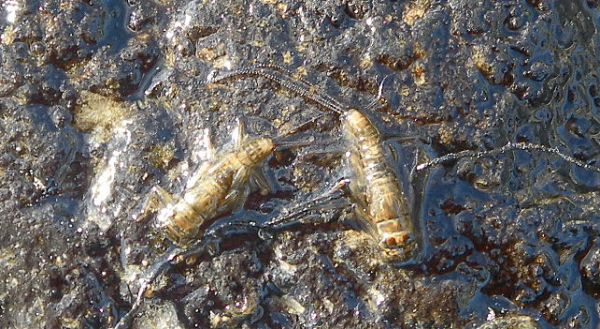
Keep at em guys
Mike |
|
|
| Back to Top |
|
|
|
|
|
|
|